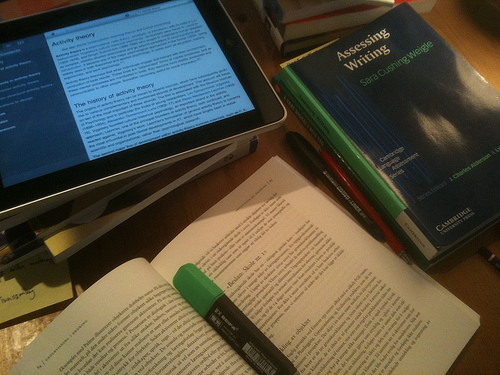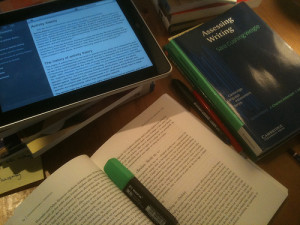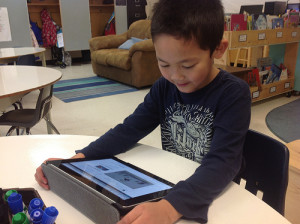
Learning to Read Digital Text

During presentations the comment:
“So you think we should do away with all physical books?”
comes up from time to time. Do I?
When it comes to non-fiction books I believe at the Middle School and High School level we need to start thinking hard about where we spend our money. On non-fiction books that are outdated before they’re checked out, or take that same money, buy devices, show students how to find quality non-fiction up-to-date information on the Internet within their reading level? I think the latter is a better choice.
Now when it comes to pleasure reading….I don’t care what form the material comes in. Books are great…there is a physical connection that some people have with books and so physical books are great…fill your library up with books kids want to read for fun.
But here’s the thing…no matter where you are in your own transition into a digital reading world we all read more digitally. Emails, Facebook, News, this blog post (unless you printed it off). Just sit back and reflect for a moment how much of your day is reading digital text. Even if you like to read before bed you probably read more online during the day.
Of course this all focused on our generation. A generation that in our childhood and schooling years grew up with book based media. The strategies we were taught, how we read, what we read all goes back to those early years.
What happens however when your early years include digital text as much as, if not more than, print text? What happens when you can look not too far into the future and take a pretty educated guess that the majority of your reading life will be done digitally. I’m not saying it’s right…I’m not saying it’s wrong. I’m just saying that’s the way we’re trending.
So if we’re really concerned about students and preparing them for their future we need to start teaching them the skills of reading digital based text.
When Pennington’s seventh graders took the Smarter Balanced Assessment in English Language Arts on new Chromebooks last April, Pennington didn’t teach them how to use the test’s annotation feature. Students would have been able to highlight reading passages and take notes on the text to help them answer test questions. He thought it was too complicated for them to learn how to use well in time for the test. ~ Mindshift

This quote is taken out of context a bit as the article is really good and pro digital reading skills. What worries me is that we are testing students using digital means but we’re not teaching them the skills of reading digitally. If we’re going to use testing systems like the Smarter Balanced Assessment that’s fine….but allow teachers and students access to the platform all year long so that they can teach the skill of digital highlighting and note taking so they can be successful.
“Wolf is optimistic that we can learn to navigate online reading just as deeply as we once did print—if we go about it with the necessary thoughtfulness. In a new study, the introduction of an interactive annotation component helped improve comprehension and reading strategy use in a group of fifth graders. It turns out that they could read deeply. They just had to be taught how.” ~ Mindshift
Yes…we can read deeply online….many of us have adapted to doing it already. But if we want to have students read deeply online we can’t use the same skills of reading print media as we do reading digital media. The skills change, you can look up definitions on the fly, you can copy and paste, you can click on hyperlinks, you can make notes, highlight passages. There are a ton of things that are built into most online reading platforms that are never taught to students. Or we try to teach them the same way as we did in a print world and that doesn’t work.
Of course educators need to know these new skills for reading online as well. There’s not being taught to new teachers, and very little PD is being offered to teachers to learn how to teach digital reading skills…but don’t worry we’ll continue to test students reading ability on a digital platform.
Being a Better Online Reader ~ Worth your time







Jeff,
This resonates so much with what I have observed as well.
I think the (misplaced) expectation is that, since kids these days are digital natives, they somehow, magically, ‘ought’ to know (“My! Look at those fingers fly!”).
Rajesh.
I totally agree. Sure they can flick this way and zoom that way. But when it comes to really knowing how to use the device in a meaningful way, I find very few that know how to use it. When it comes to reading…..nobody has been taught the skills of reading digital text and it’s a skill that really needs to be taught if we want students to read deep digitally.
I`ve noticed the trend to skip through digital text, especially when in some moment it gets “too complicated”. I do agree with you that digital reading skills should be developed as well. Thanks for your post, really insightful.
I agree with the statement that the world is changing each day where more and more people are using digital technology. From emails to Facebook, almost everyone turns to a form of digital reading at some point. This is showing through the younger generations more and more. Students in elementary schools are carrying cell phones. It is becoming a modern technology world. I believe that the classroom should be changing with it. I think the digital reading in the classroom creates a lot of benefits for students. More up to date texts and topics and it allows students to take notes and highlight a text. It can also lend itself to having the students type answer or blog on the digital devices while they are reading a text.
Hi Jeff,
I thought about the idea of digital reading when you were visiting ASFM. The Z-pattern that you talked about is what newspapers have been basing their design on for decades.
It is nice to help students understand that this is not a totally new approach; rather it is connected to other informational reading strategies they know.
The new aspect is what happens to readers as they click off of a given page.
I read almost everything digitally nowadays as it is easy to procure both fiction and non-fiction texts digitally while living abroad.
Keep up the inspiration!
Jen